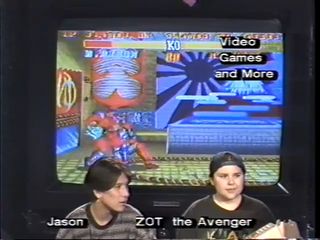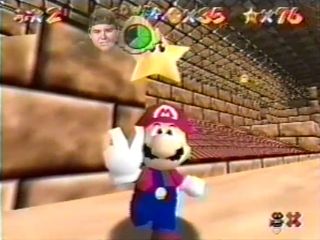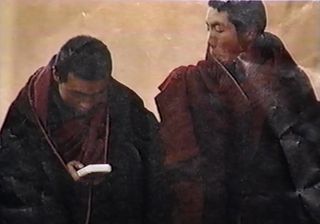Meet the original streamer, who ran his own public access gaming show in 1993
12-year-old J.J. Styles' local TV show was the predecessor to modern gaming culture decades before Twitch.
Zot the Avenger is in a world of his own. Onscreen, the long-haired 12-year-old carries himself like a cheeky, slightly awkward teen, complete with backwards baseball cap and baggy t-shirt. Zot—with a steady, practiced cadence and carefully cultivated air of confidence—is here to talk to you about fighting games on his program Video Games and More. The games are projected on a screen behind him, including the telltale blur of a camera being pointed at a CRT TV. As he fires up Street Fighter II as Balrog, he takes his first live call on a chunky beige corded phone.
Because of his age, Styles had an innate understanding of his core demographic: other kids.
This isn't a retro Twitch stream or a YouTube show about vintage hardware. It's an early 1990s public access television show that aired on Access Tucson in Arizona almost 20 years before Twitch.tv was born.
"Are you going to show the code for Mortal Kombat?" asks an excited kid on the line. Zot is prepared for any code, any game system. He stops playing and leans back in his seat. "People in the control room, put up the CG," he says, and the controversial blood cheat code for the Super Nintendo version of Mortal Kombat appears on the screen. In 1993, the game set off an unprecedented wave of controversy about gore and violence in videogames. But before Google or even broadband, unflappable Zot was simply here to give the kids what they wanted.
"I really like this nickname people are giving me—'the original streamer,'" says Zot, better known as J.J. Styles. It's 2 am in Arizona—his AI assistant just announced the time during our Zoom call—and the original streamer is telling me about the first documented instance of videogame streaming. Our interview was conditional: he wanted to get to know me before agreeing to be interviewed, and we spent close to an hour talking about my background. When I tell him I used to live in LA, he immediately tells me about his memories of living on Venice Beach. Styles is enthusiastic about the cyberpunk ethos, technology as a great equalizer, and the importance of archiving. He's currently working with the Internet Archive to make a permanent online home for his series.
Streams like teen spirit
Video Games and More was born in 1993, long before the widespread idea of the internet as a utility. "My main hopes for Video Games and More were to get on the air and say, 'Hey guys, I've been doing this thing that is really cool, and I think there's other people that might enjoy it that might not know about it, and I'm going to tell you about it," he explains.
Styles fell into community television through his mother, who had been involved in an adopted children's organization to find her birth parents. Much like a Facebook group or subreddit would today, a public access TV show helped them get the word out about the support group. His mom, an avid proponent of new technology, brought him down to the public access studio, where he took classes on how to light a set, operate the cameras, and use the editing equipment.
"I remember after my first camera class, I worked four TV shows in the same day, just back to back to back," Styles recalls. "When I was 10 years old, I had a knack for it… so I started to work with younger people, teenagers… [on] productions like The Forbidden Zone and Spanked, and real Gen-X type stuff." After a year of working on other people's projects—including everything from religious programming to community awareness shows—Styles caught Wayne's World fever. What if he combined his love of Wayne's World-style talk shows with stuff that he already did: playing games with friends while trash talking and sharing things that he liked?
The biggest gaming news, reviews and hardware deals
Keep up to date with the most important stories and the best deals, as picked by the PC Gamer team.

The very first two episodes of Video Games and More were made in a cafe across the street from the TV station where there was a live feed that people could use. Styles now describes them as a prequel of sorts to the 37-episode series. "I think it was around late '93, because it was around the time the Buffalo Bills were playing the Cowboys in the Superbowl," he muses (he was close—Super Bowl XXVII was on January 31, 1993). "But when we first did the studio show, we played EA Sports NHL '93 for Sega Genesis, and Mortal Kombat Genesis, and I'm just trash talking the whole time." The willing target of said trash-talk was his friend Jason Kingman. "I was working on his program, directing it, and I said, 'Look, you need to help be a co-host on my show, because I don't want to do this alone," Styles recalls. "That's too much pressure for a 12-year-old kid."
Because of his age, Styles had an innate understanding of his core demographic: other kids. He believes that the average estimated viewership at the time was around 50 people. When I bring up an episode where he tells a caller that the Game Boy sucks as a console, he explains that he couldn't play in the dark without the battery-powered light magnifying glass attachment. "That was disappointing because, I mean, kids, they got no money, you know? How am I gonna come up with batteries all the time?"

Styles also came up with ways to save on his show's production costs. He'd figured out a way to use a soldering iron or a drill to make a normal VHS tape into an S-VHS tape, which were slightly more expensive and had a higher resolution. He even applied for a mini-grant from Access Tucson for free S-VHS tapes. Once he had enough tapes to make a personal copy of each show for himself, he started submitting the shows for reruns.
For an average episode he'd record himself playing a game on VHS tape and do A/B-roll edits at the TV station's editing bay facilities. He was especially proud of the Zot the Avenger logo that he made with Deluxe Paint on an Amiga 2000. "I programmed in the x-y-z coordinates that cause the 3D flip," he says, and I can almost feel his pride through the ether. "I'm very proud of myself for what I accomplished at that TV studio because I applied myself. I did not rely on anyone except my crew members… they got incorporated into the program usually, because I was a little control freak that would tell them what to do live on the air."
Styles' mother had encouraged him to get an Apple II computer with some residuals that he'd earned from a McDonald's commercial, so he was armed with something most kids didn't have. "I was an early adopter of dial-up internet through AZ Starnet, which was providing unlimited internet in my area, which was a big deal back then," he says. After teaching himself HTML through computer magazines, he made his first website and began harvesting cheat codes and walkthroughs online. Other kids would have to wait for magazines to show up in the mail—or watch his show.
Video Games and More might not have had Twitch chat, but trolls could still call in.
Nobody accused me of corrupting their kids with my devil video game footage.
J.J. Styles
The show's format, too, was born from Styles' voracious appetite for new technology. He subscribed to a plethora of magazines: Game Players, Electronic Gaming Monthly, Nintendo Power, and Sega Visions, to name a few. "My mind was filled with video games, news, on-the-cutting-edge-stuff," he says. He knew exactly what to look forward to—the Sega CD and 32x, the fabled Sega Genesis virtual reality helmet—way ahead of the average kid. And so on some episodes, besides sharing games he'd recently enjoyed or doing live playthroughs, he also read out bits of hardware news.
"Video games have always been out of reach for kids, because it's pricey hardware," he says. "So if you're gonna beg your parents for a birthday present... You need to know in advance what to beg for, and I tried to provide that information because I knew how critical it was."
With Zot's great power also came great responsibility—there were still rules on public access, even though the FCC didn’t really do much about "indecency and profanity" on cable. Thanks to "mature" games like Mortal Kombat, video games in the '90s were a hotly discussed topic. "Even though I was still a little kid, I was still a producer," Styles says. "And I could be held accountable for anything that I put out there." He describes another local producer, Lou Perfidio, a shock jock who called himself the "Great Satan." Perfidio allowed masturbation and live-pierced women's body parts on air, and committed the ultimate sin of drinking alcohol on his program. The show was quickly booted off the air.
"I never got in trouble, I guess," he says. "Nobody accused me of corrupting their kids with my devil video game footage. So I always wondered if that was good. I kind of feared it in the back of my mind, but I tried not to live with fear because that's a real buzzkill."
In 1997 Video Games and More came to an end—Styles had to focus on school where he was studying computer programming, and he'd become more involved in the music scene. His weapon of choice was bass guitar, and today, he's a music producer. "It wasn't any big deal to me. I didn't need a ceremony," he says. He still meets up with his old director, Mark, to play pinball games, but doesn’t follow much streaming culture—he’s busy creating music and videos and art.
"As much as I would like to, I consume more radio, like over-the-air local radio," he says. "I have the program reminders [for Twitch]… but I have to catch whatever might be on at the time."

Even now—perhaps especially now—Styles believes in the power of technology to change the world. "It is about the sharing, and in a lot of ways, streaming is a total, complete replacement for television and radio," he says. "It's not on demand, you got to catch it while it's happening." It's clear that as Zot, he took his responsibility very seriously, and poured an immense amount of energy into his passion for games through his work. Today, Styles sincerely believes in using technology to improve communication and bring about world peace through sportsmanship.
"You’ve got a winner and you’ve got a loser, and yes, it does suck to be a loser," he says—a mindset which goes against the grain of today’s aspirational streaming culture. "But if anybody checks out my music, they’ll realize that I’m just one of those people that was born to lose. It’s a phrase, and it’s fine. There’s nothing wrong with being a born loser."
It’s clear that Video Games and More was more than just a show -- it’s the ancestor of the modern game stream. "That was the thing that united us and brought us together, was the tech and the availability," Styles says of his time at Access Tucson. "Nobody there was rich. We were all coming [together] and taking advantage of very expensive equipment that we would normally never would have had access to, in order to share our messages. And that is just so cyberpunk."
Listening to him reflect on his place in streaming history is almost alien in our current media landscape, but it's also startlingly earnest. "I was so aware of what I was putting out there," he says. "And the more power you give a kid, you know, the mores responsible they're going to be. And streaming is power."

Alexis Ong is a freelance culture journalist based in Singapore, mostly focused on games, science fiction, weird tech, and internet culture. For PC Gamer Alexis has flexed her skills in internet archeology by profiling the original streamer and taking us back to 1997's groundbreaking all-women Quake tournament. When she can get away with it she spends her days writing about FMV games and point-and-click adventures, somehow ranking every single Sierra adventure and living to tell the tale.
In past lives Alexis has been a music journalist, a West Hollywood gym owner, and a professional TV watcher. You can find her work on other sites including The Verge, The Washington Post, Eurogamer and Tor.
Most Popular


